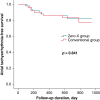Safety and efficacy of intracardiac echocardiography-guided zero-fluoroscopic cryoballoon ablation for atrial fibrillation: a prospective randomized controlled trial
- PMID: 37021403
- PMCID: PMC10228535
- DOI: 10.1093/europace/euad086
Safety and efficacy of intracardiac echocardiography-guided zero-fluoroscopic cryoballoon ablation for atrial fibrillation: a prospective randomized controlled trial
Abstract
Aims: The development of intracardiac echocardiography (ICE) has enabled fluoroless atrial fibrillation (AF) ablation using three-dimensional electroanatomical mapping systems. However, fluoroless cryoballoon ablation (CBA) remains challenging, mainly because of the lack of a visual mapping system. Hence, this study aimed to investigate the safety and efficacy of fluoroless CBA for AF under ICE guidance.
Methods and results: Patients (n = 100) who underwent CBA for paroxysmal AF were randomly assigned to zero-fluoroscopic (Zero-X) and conventional groups. Intracardiac echocardiography was used to guide the transseptal puncture and catheter and balloon manipulation in all enrolled patients. The patients were prospectively followed for 12 months after CBA. The mean age was 60.4 years, and the left atrial (LA) size was 39.4 mm. Pulmonary vein isolation (PVI) was achieved in all patients. In the Zero-X group, fluoroscopy was used in only one patient because of unstable phrenic nerve capture during right-sided PVI. The procedure time and LA indwelling time in the Zero-X group were not statistically different compared with that in the conventional group. Fluoroscopic time (9.0 vs. 0.008 min) and radiation exposure (29.4 vs. 0.02 mGy) were significantly shorter in the Zero-X group than in the conventional group (P < 0.001). The complication rate did not differ between the two groups. During a mean follow-up of 663.3 ± 172.3 days, the recurrence rate was similar (16.0 vs. 18.0%; P = 0.841) between the groups. Multivariate analysis revealed that LA size was the only independent predictor of clinical recurrence.
Conclusion: Intracardiac echocardiography-guided fluoroless CBA for AF was a feasible strategy without compromising acute and long-term success or complication rates.
Keywords: Atrial fibrillation; Cryoballoon ablation; Intracardiac echocardiography; Radiation exposure.
© The Author(s) 2023. Published by Oxford University Press on behalf of the European Society of Cardiology.
Conflict of interest statement
Conflict of interest: None declared.
Figures




Similar articles
-
The use of Intracardiac Echocardiography in Catheter Ablation of Atrial Fibrillation.Curr Cardiol Rep. 2024 Sep;26(9):893-901. doi: 10.1007/s11886-024-02091-w. Epub 2024 Jul 12. Curr Cardiol Rep. 2024. PMID: 38995505 Review.
-
Impact of intracardiac echocardiography usage on the safety of cryoballoon atrial fibrillation ablation: Subanalysis of the prospective FREEZE cluster cohort study.J Cardiovasc Electrophysiol. 2023 Oct;34(10):2029-2039. doi: 10.1111/jce.16060. Epub 2023 Sep 8. J Cardiovasc Electrophysiol. 2023. PMID: 37681996
-
Implementation of a zero fluoroscopic workflow using a simplified intracardiac echocardiography guided method for catheter ablation of atrial fibrillation, including repeat procedures.BMC Cardiovasc Disord. 2021 Aug 26;21(1):407. doi: 10.1186/s12872-021-02219-8. BMC Cardiovasc Disord. 2021. PMID: 34433424 Free PMC article.
-
Zero-fluoroscopy transseptal puncture guided by right atrial electroanatomical mapping combined with intracardiac echocardiography: A single-center experience.Clin Cardiol. 2020 Sep;43(9):1009-1016. doi: 10.1002/clc.23401. Epub 2020 Jun 7. Clin Cardiol. 2020. PMID: 32506504 Free PMC article. Clinical Trial.
-
Fluoroless Atrial Fibrillation Catheter Ablation: Technique and Clinical Outcomes.Card Electrophysiol Clin. 2020 Jun;12(2):233-245. doi: 10.1016/j.ccep.2020.01.001. Card Electrophysiol Clin. 2020. PMID: 32451107 Review.
Cited by
-
The use of Intracardiac Echocardiography in Catheter Ablation of Atrial Fibrillation.Curr Cardiol Rep. 2024 Sep;26(9):893-901. doi: 10.1007/s11886-024-02091-w. Epub 2024 Jul 12. Curr Cardiol Rep. 2024. PMID: 38995505 Review.
-
Occupational radiation exposure of electrophysiology staff with reproductive potential and during pregnancy: an EHRA survey.Europace. 2023 Aug 2;25(9):euad216. doi: 10.1093/europace/euad216. Europace. 2023. PMID: 37498147 Free PMC article.
-
Feasibility and safety of zero-fluoro, "apron-less" approach to repeat pulmonary vein isolation procedures using radiofrequency energy after initial cryoballoon ablation.Sci Rep. 2025 Feb 4;15(1):4280. doi: 10.1038/s41598-025-87940-6. Sci Rep. 2025. PMID: 39905074 Free PMC article.
-
2024 European Heart Rhythm Association/Heart Rhythm Society/Asia Pacific Heart Rhythm Society/Latin American Heart Rhythm Society expert consensus statement on catheter and surgical ablation of atrial fibrillation.Europace. 2024 Mar 30;26(4):euae043. doi: 10.1093/europace/euae043. Europace. 2024. Corrected and republished in: Heart Rhythm. 2024 Sep;21(9):e31-e149. doi: 10.1016/j.hrthm.2024.03.017. PMID: 38587017 Free PMC article. Corrected and republished.
-
Catheter Ablation for the Management of Atrial Fibrillation: An Update of the Literature.Life (Basel). 2023 Aug 21;13(8):1784. doi: 10.3390/life13081784. Life (Basel). 2023. PMID: 37629641 Free PMC article. Review.
References
-
- Hindricks G, Potpara T, Dagres N, Arbelo E, Bax JJ, Blomström-Lundqvist Cet al. . 2020 ESC guidelines for the diagnosis and management of atrial fibrillation developed in collaboration with the European Association for Cardio-Thoracic Surgery (EACTS): the task force for the diagnosis and management of atrial fibrillation of the European Society of Cardiology (ESC) developed with the special contribution of the European Heart Rhythm Association (EHRA) of the ESC. Eur Heart J 2021;42:373–498. - PubMed
-
- Lickfett L, Mahesh M, Vasamreddy C, Bradley D, Jayam V, Eldadah Zet al. . Radiation exposure during catheter ablation of atrial fibrillation. Circulation 2004;110:3003–10. - PubMed
-
- Limacher MC, Douglas PS, Germano G, Laskey WK, Lindsay BD, McKetty MHet al. . ACC expert consensus document. Radiation safety in the practice of cardiology. American College of Cardiology. J Am Coll Cardiol 1998;31:892–913. - PubMed
Publication types
MeSH terms
Grants and funding
LinkOut - more resources
Full Text Sources
Medical

